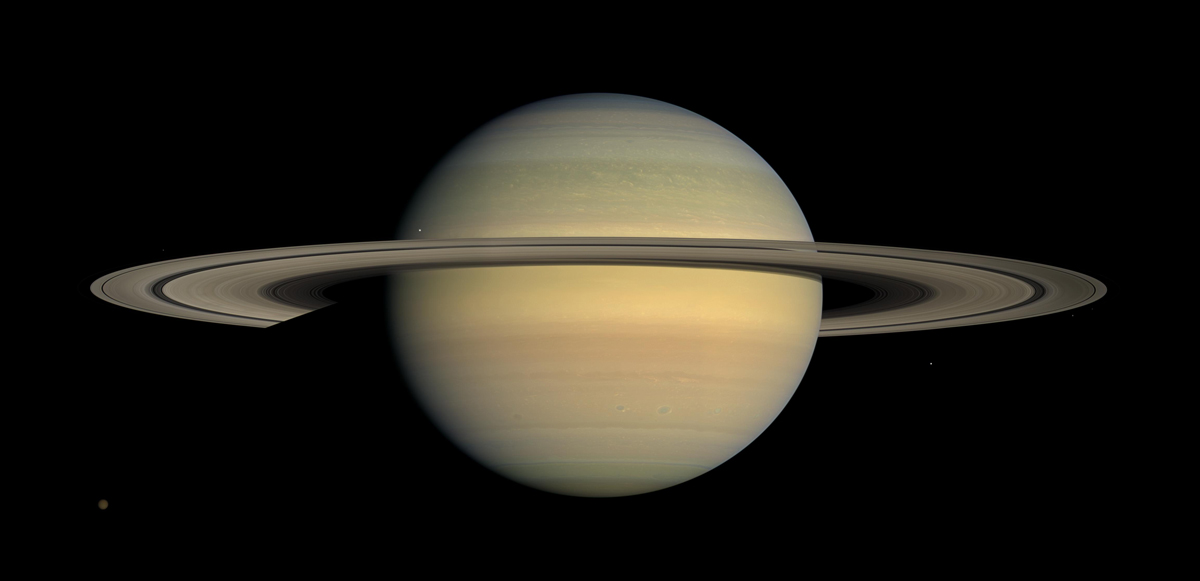The Greatest Mysteries of Saturn

Each week this summer, Life's Little Mysteries, a sister site to SPACE.com, presents The Greatest Mysteries of the Cosmos, starting with our solar system.
After Earth and perhaps Mars, Saturn might be the most-recognizable world in our solar system, courtesy of its unique and resplendent ring system.
These rings, however, are but the tip of the iceberg when it comes to the strangeness and wonder of this planet. Since 2004, NASA's Cassini spacecraft has observed Saturn, its rings and its moons in great detail. The mission is helping to solve some of the major scientific mysteries about Saturn, which are:
Where do you get those rings?
Although the other three gas giants in our solar system — Jupiter, Uranus and Neptune — also have rings, none are as dense, thick and just plain eye-popping as Saturn's. [Photos: The Rings and Moons of Saturn]
These bands of mostly icy particles start about 4,000 miles (6,437 kilometers) above Saturn's equator and extend out some 75,000 miles (120,700 kilometers) into space. Numerous gaps in the rings exist, carved out by tiny moons or from gravitational interactions with more distant orbiting bodies.
Breaking space news, the latest updates on rocket launches, skywatching events and more!
Interestingly, the rings could be young, relatively speaking, at just a few hundred million years old. Or not: they might date back to Saturn's birth more than four billion years ago.
"We don't know how the rings formed or how long they last," said Carolyn Porco, leader of the Cassini Imaging Science team and the director of the Cassini Imaging Central Laboratory for Operations (CICLOPS) at the Space Science Institute in Boulder, Colorado.
Scientists believe that the material for the rings has one of two origins: The destruction of a moon, ripped apart by Saturn's gravity or blasted apart by an impacting comet, or the ancient leftovers from Saturn's formation.
Understanding the processes that create the rings' structure will shed light on disk formation all over the universe. "Here's a place where we have the nearest analog to us in our solar system to all the disk systems in the cosmos," said Porco. "That includes other solar systems that we know are forming and also reaching a trillion times in size to the pinwheels of stars of gas and dust we call spiral galaxies."
Storms a' ragin'
Compared to the other gas giants, and especially Jupiter, Saturn's nearest neighbor in size, the ringed world has a subdued complexion of beige cloud bands. Usually, that is; last December, a huge white storm erupted in the planet's northern hemisphere. [Why Does Saturn Have Rings Around It?]
Astronomers have observed the biggest of these storms flare up every 30 years or so going back more than 180 years, Porco said. A Saturn year is equal to about 30 Earth years, suggesting some sort of seasonal connection with the storms. But if that were simply the case, the big storm raging now should not have been showed up until sometime in 2020.
The ultimate origin and power source for these massive storms are unknown. "These storms have a lot of energy in them," Porco said. "They could say something fundamental about the difference between the way giant planet atmospheres work and, say, the atmospheres of Earth or Venus."
Puzzling polar hexagon
In the early 1980s, the passing Voyager spacecraft spotted a surprising six-sided cloud pattern above Saturn's north pole. Cassini has followed up in recent years with close-ups of this strangely shaped weather phenomenon, which could hold four Earths within its boundaries.
Researchers have simulated hexagonal and other polygonal shapes by whirling liquid inside a tank at varying speeds, suggesting Saturn's "hexagon might be an oddity of fluid mechanics on a rotating body," said Porco.
Nevertheless, the remarkable longevity and stability of this jet stream will have scientists scratching their heads for years to come.
Bonus boggler: Nailing down the day length
Gauging the length of the day on Saturn — or any other gas giant — is tricky. Unlike a world with solid ground and landmarks, the cloud patterns on a gas giant do not necessarily represent the internal spinning of the interior and the core. [Will We Really Find Alien Life in 20 Years?]
To compensate, scientists record a planet's rhythm of naturally generated radio emissions. Such a technique worked well for Jupiter, and seemed to for Saturn based on Voyager data. Yet Cassini's measurements in 2004 indicated a day mysteriously longer by about six minutes.
Later work showed that Saturn's magnetic field, which produces the radio signals, does not stay in sync with the rotation of the planet. (For Jupiter, the fact that the two phenomena are clearly not hitched makes for easier day-length calculations.)
Overall, scientists have had to average data from the Pioneer, Voyager and Cassini probes to best-guesstimate: Saturn's days last 10 hours, 32 minutes, and 35 seconds (give or take 13 seconds).
That's pretty precise. Over a Saturn year, however, that margin of error can add up to about four Saturn days' worth of extra or subtracted calendar space, which could definitely mess up a meticulous-kept day planner.
This article was provided by Life's Little Mysteries, a sister site to SPACE.com. Follow us on Twitter @llmysteries, then join us on Facebook.
Join our Space Forums to keep talking space on the latest missions, night sky and more! And if you have a news tip, correction or comment, let us know at: community@space.com.

Adam Hadhazy is a contributing writer for Live Science and Space.com. He often writes about physics, psychology, animal behavior and story topics in general that explore the blurring line between today's science fiction and tomorrow's science fact. Adam has a Master of Arts degree from the Arthur L. Carter Journalism Institute at New York University and a Bachelor of Arts degree from Boston College. When not squeezing in reruns of Star Trek, Adam likes hurling a Frisbee or dining on spicy food. You can check out more of his work at www.adamhadhazy.com.

